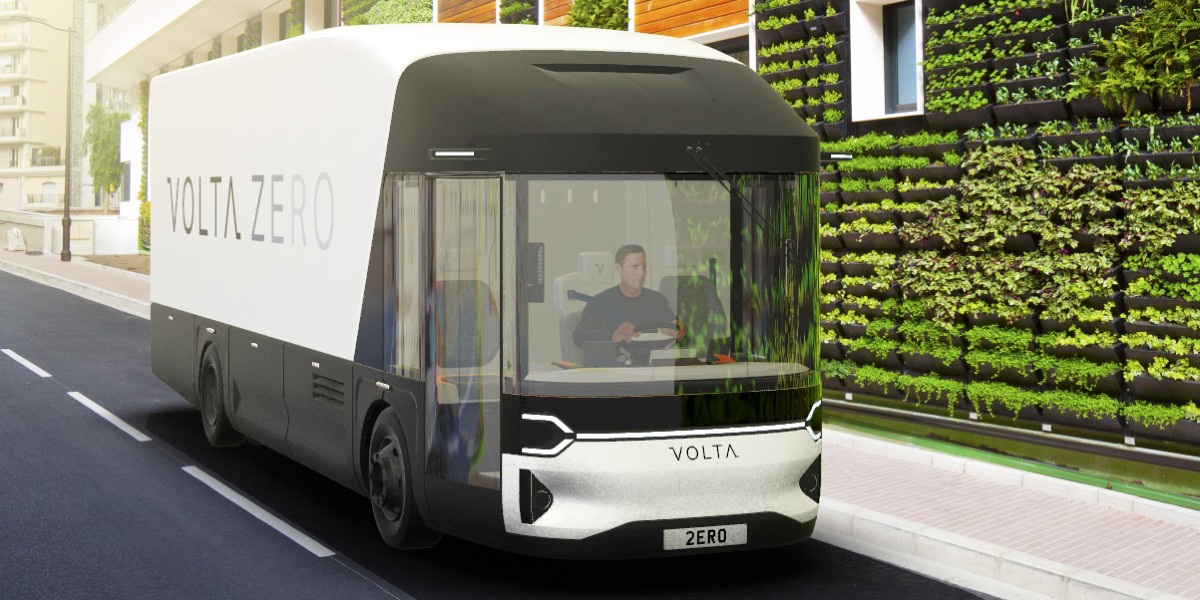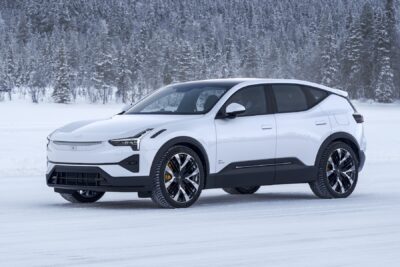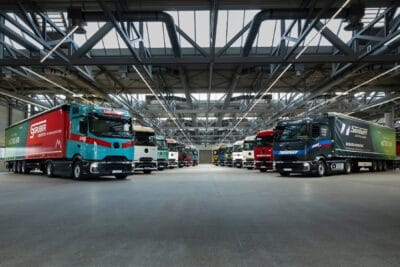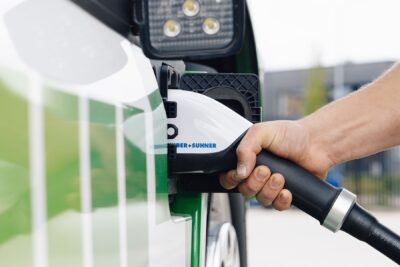Volta Zero: delivery e-truck using organic space materials
Volta Trucks, a startup with offices in Sweden and the UK, is working on the prototype of an all-electric 16-ton truck. The Volta Zero, due for launch later this year is to use hi-tech organic materials developed together with the European Space Agency, ESA.
++ Kindly find all updates to this article below. ++
But first to the more down to earth data available so far. Volta envisions their e-truck doing innercity logistics with zero tailpipe emissions. Measuring 9.46 x 2.55 x 3.4 metres and with an 8.6-ton payload, the vehicle features an unspecified electric drivetrain powered by 160-200 KWh battery pack. Volta Power promises a range of 150 to 200 km (93-124 miles) at a maximum speed of up to 90 kph (50-56 mph) – enough for city driving.
Volta claims the motor position, or rather the lack of an internal combustion engine helps position the operator in a central driving position, with a lower seat height than a conventional truck. The cab design with glass all around gives the driver a wide 220-degrees of visibility, while cameras sort out the remaining blind spots.
Talking about the design, the truck’s body is made from natural Flax material and biodegradable resins. Bcomp of Switzerland supplies Volta Trucks with the composite developed in collaboration with the European Space Agency. The high-tech Flax consists of flax fibres mixed with biodegradable resins (made by British Bamp). The result is what Volta describes as a “fully natural, extremely lightweight, high-performance fibre reinforcement that is almost CO2 neutral over its lifecycle”. More so, the panels “can match the stiffness and weight of carbon fibre but use 75% less CO2 to produce,” says the company.
Rob Fowler, Chief Executive Officer of Volta Trucks, believes “that sustainability is more than just tailpipe emissions,” when explaining the company’s “environmental-first approach to all material sourcing”. However, we’ve yet to see the prototypes in action.
The company is currently constructing the first units together with the British Prodrive. Volta Trucks is hoping to launch the first Volta Zero later this year with the first pilot tests with potential customers to start in the first quarter of 2021. The trials will run as ‘Pioneer Programme’ according to the company’s website. In another announcement, Volta Trucks names Bring and Posten, distributor of parcels, cargo, and mail in the Nordic region, as partners for an “exclusive trial of its forthcoming Volta Zero”.
In the mid-term, they hope to make 2,000 electric trucks a year. Volta Trucks has yet to specify where and how they will make these numbers.
Update 03 September 2020: Volta Trucks has provided additional details about the Volta Zero and updated some numbers in an online premiere. For example, the vehicle is to be built from 2022 onwards by a contract manufacturer in the UK – the pre-series vehicles are known to be built by Prodrive and Astheimer. By the end of 2022, 500 units are to be built and then production is to be increased to 5,000 vehicles per year in 2025, which is a considerable increase from the expected figure of 2,000 units per year.
Trials are to be started with a few pre-series vehicles “with Europe’s largest logistics company” in the first half of 2021, as Volta now writes in a blog entry. The companies involved were not named specifically, but apparently include “some of the largest parcel delivery and logistics companies in Europe”.
In the blog entry, Volta has now also revealed some figures about the new cockpit design described above in the article. With an eye-level of 1.8 meters, the driver sits significantly lower than in conventional trucks in this size class. In addition, the driver’s field of vision from the central position should be 220 degrees thanks to the large glass surfaces. A camera system is to support the driver for the complete 360-degree all-round view.
In terms of propulsion, Volta confirms that it is aiming for a range of 150 to 200 kilometres. This is “more than sufficient for the daily use of a ‘last-mile’ delivery vehicle and has been validated using simulations with a fall payload”. The batteries should be between 160 and 200 kWh. According to the blog, Volta has opted for LFP batteries. These will be modular to allow Volta Zero to be adapted to the operator’s specific requirements. In terms of the company’s choice of LFP technology, Volta cites the battery’s durability, robust cell design and increased safety with thermal stability.
Volta has also extrapolated on information about the electric motor: Volta is focusing on an integrated e-axle to drive the rear wheels. The electric motor, transmission and axle are combined into a lightweight and compact unit. This should offer advantages in terms of installation space, which Volta wants to use to accommodate the battery. Volta has not yet made mention of the performance data for the e-axle – nor has the company said whether this is an in-house development or (probably) a supplier component.
Update 27 January 2021: The Swedish startup Volta Trucks has closed a financing round of 20 million US dollars. The fresh capital comes from new investor Luxor Capital Group. Volta Trucks says it already has orders worth 260 million US dollars for its Volta Zero e-truck.
voltatrucks.com, voltatrucks.com (Pioneer Programme), voltatrucks.com (Bring & Posten), newatlas.com, voltatrucks.com (update), voltatrucks.com (update II)





0 Comments